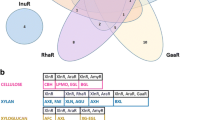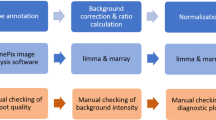Abstract
Aspergillus oryzae is a fungus used extensively in the fermentation industry. We constructed cDNA microarrays comprising 2,070 highly expressed cDNAs selected from the ∼6,000 non-redundant expressed sequence tags (ESTs) in the A. oryzae EST database (http://www.aist.go.jp/RIODB/ffdb/index.html). Using the cDNA microarrays, we analyzed the gene expression profiles of A. oryzae cells grown under the glucose-rich (AC) and glucose-depleted (AN) liquid culture conditions used during the construction of the EST database. The sets of genes identified by the cDNA microarray as highly expressed under each culture condition agreed well with the highly redundant ESTs obtained under the same conditions. In particular, transcription levels of most catabolic genes of the glycolytic pathway (EMP) and tricarboxylic acid (TCA) cycle were higher under AC than AN conditions, suggesting that A. oryzae uses both EMP and TCA for glucose metabolism under AC conditions. We further studied the expression of genes encoding hydrolytic enzymes and enzymes involved in energy catabolism by using three industrial solid-phase biomass media, including wheat-bran. The wheat-bran culture gave the richest gene expression profile of hydrolytic enzymes and the lowest expression levels of catabolic genes (EMP, TCA) among the three media tested. The low expression levels of catabolic genes in the wheat-bran culture may release catabolite repression, consequently leading to the rich expression profiles of the hydrolytic enzymes.




Similar content being viewed by others
References
Akao T, Gomi K, Goto K, Okazaki N, Akita O (2002) Subtract cloning of cDNA from Aspergillus oryzae differentially regulated between solid-state culture and liquid (submerged) culture. Curr Genet 41:275–281
Azuma N, Suda H, Iwasaki H, Kanamoto R, Iwami K (1999) Soybean curd refuse alleviates experimental tumorigenesis in rat colon. Biosci Biotechnol Biochem 63:2256–2258
Barbesgaard P, Heldt-Hansen HP, Diderichsen B (1992) On the safety of Aspergillus oryzae: a review. Appl Microbiol Biotechnol 36:569–572
Cathala G, Savouret J-F, Mendez B, West BL, Karin M, Martial JA, Baxter JD (1983) A method for isolation of intact, translationally active ribonucleic acid. DNA 2:329–335
Chambergo FS, Bonaccorsi ED, Ferreira AJ, Ramos AS, Ferreira JR Jr, Abrahao-Neto J, Farah JP, El-Dorry H (2002) Elucidation of the metabolic fate of glucose in the filamentous fungus Trichoderma reesei using expressed sequence tag (EST) analysis and cDNA microarrays. J Biol Chem 277:13983–13988
Chigira Y, Abe K, Gomi K, Nakajima T (2002) chsZ, a gene for a novel class of chitin synthase from Aspergillus oryzae. Curr Genet 41:261–267
Christensen T, Woeldike H, Boel E, Mortensen SB, Hjortshoejk K, Thim L, Hansen MT (1988) High-level expression of recombinant genes in Aspergillus oryzae. Biotechnology 6:1419–1422
Couri S, da Costa Terzi S, Saavedra Pinto GA, Pereira Freitas S, Augusto da Costa AC (2000) Hydrolytic enzyme production in solid-state fermentation by Aspergillus niger 3T5B8. Process Biochem 36:255–261
Cubero B, Scazzocchio C (1994) Two different, adjacent and divergent zinc finger binding sites are necessary for CreA-mediated catabolite repression in the proline gene cluster of Aspergillus nidulans. EMBO J 13:407–415
DeRisi JL, Iyer VR, Brown PO (1997) Exploring the metabolic and genetic control of gene expression on a genomic scale. Science 278:680–686
Flipphi M, Mathieu M, Cirpus I, Panozzo C, Felenbok B (2001) Regulation of the aldehyde dehydrogenase gene (aldA) and its role in the control of the coinducer level necessary for induction of the ethanol utilization pathway in Aspergillus nidulans. J Biol Chem 276:6950–6958
Flipphi M, van de Vondervoort PJ, Ruijter GJ, Visser J, Arst NH Jr, Felenbok B (2003) Onset of carbon catabolite repression in Aspergillus nidulans. Parallel involvement of hexokinase and glucokinase in sugar signaling. J Biol Chem 278:11849–11857
Flores CL, Rodriguez C, Petit T, Gancedo C (2000) Carbohydrate and energy-yielding metabolism in non-conventional yeasts. FEMS Microbiol Rev 24:507–529
Gancedo JM (1998) Yeast carbon catabolite repression. Microbiol Mol Biol Rev 62:334–361
Gouka RJ, Punt P, van den Hondel CA (1997) Efficient production of secreted proteins by Aspergillus, progress, limitations, and prospects. Appl Microbiol Biotechnol 47:1–11
Hatamoto O, Sekine H, Nakano E, Abe K (1999) Cloning and expression of a cDNA encoding the laccase from Schizophyllum commune. Biosci Biotechnol Biochem 63:58–64
Jeenes DJ, Mackenzie B, Mackenzie DA, Archer DB (1991) A truncated glucoamylase gene fusion for heterologous protein secretion from Aspergillus niger. FEMS Microbiol Lett 107:267–271
Jones I, Fairhurst V, Sealy-Lewis HM (2001) ADHII in Aspergillus nidulans is induced by carbon starvation stress. Fungal Genet Biol 32:33–43
Kelly J, Drysdale MR, Sealy-Lewis HM, Jones IG, Lockington RA (1990) Alcohol dehydrogenase III in Aspergillus nidulans is anaerobically induced and post-transcriptionally regulated. Mol Gen Genet 222:323–328
Klumberg P, Mathieu M, Dowzer CEA, Kelly JM, Felenbok B (1993) Specific binding sites in the alcR and alcA promoters of the ethanol regulon for the CreA repressor mediating carbon catabolite repression in Aspergillus nidulans. Mol Microbiol 7:847–857
Latge JP (1999) Aspergillus fumigatus and aspergillosis. Clin Microbiol Rev 12:310–350
Machida M (2003) Progress of Aspergillus oryzae genomics. Genomics for fungi. Appl Microbiol 51:81–106
Machida M, Chang YC, Manabe M, Yasukawa M, Kunihiro S, Jigami Y (1996) Molecular cloning a cDNA encoding enolase from the filamentous fungus, Aspergillus oryzae. Curr Genet 30:423–431
Mod RR, Conkerton EJ, Ory RL, Normand FL (1978) Hemicellulose composition of dietary fiber of milled rice and rice bran. J Agric Food Chem 26:1031–1035
Nakajima K, Kunihiro S, Sano M, Zhang Y, Eto S, Chang Y-C, Suzuki T, Jigami Y, Machida M (2000) Comprehensive cloning and expression analysis of glycolytic genes from the filamentous fungus, Aspergillus oryzae. Curr Genet 37:322–327
Narahara H, Koyama Y, Yoshida T, Pichangkura S, Ueda R, Taguchi H (1982) Growth and enzyme production in solid-state culture of Aspergillus oryzae. J Ferment Technol 60:311–319
Tailor MJ, Richardson T (1979) Applications of microbial enzymes in food systems and in biotechnology. Adv Appl Microbiol 25:7–35
Takahashi T, Chang P-K, Matsushima K, Yu J, Abe K, Bhatnagar D, Cleveland TE, Koyama Y (2002) Non-functionality of Aspergillus sojae aflR in a strain Aspergillus parasiticus with a disrupted aflR gene. Appl Environ Microbiol 68:3737–3743
Tsuchiya K, Tada S, Gomi K, Kitamoto K, Kumagai C, Jigami Y, Tamura G (1992) High level expression of the synthetic human lysozyme gene in Aspergillus oryzae. Appl Microbiol Biotechnol 38:109–114
Tsuchiya K, Gomi K, Kitamoto K, Kumagai C, Tamura G (1993) Secretion of calf chymosin from the filamentous fungus Aspergillus oryzae. Appl Microbiol Biotechnol 40:327–332
Yu J, Proctor RH, Brown DW, Abe K, Gomi K, Machida M, Hasegawa F, Nierman WC, Bhatnagar D, Cleveland TE (2004) Genomics of economically significant Aspergillus and Fusarium species. In: Arora KD, Khachatourians GG (eds) Applied mycology and biotechnology, vol 4, Fungal genomics. Elsevier, Amsterdam, pp 249–283
Zeeman AM, Kuyper M, Pronk JT, van Dijken JP, Steensma HY (2000) Regulation of pyruvate metabolism in chemostat cultures of Kluyveromyces lactis CBS 2359. Yeast 16:611–927
Acknowledgements
This work was supported in part by a grant-in-aid (Proposal-based Energy/Environment International Joint Research Program) from the New Energy and Industrial Technology Development Organization (NEDO) of Japan as well as a grant-in-aid (Bio Design Program) from the Ministry of Agriculture, Forestry and Fisheries of Japan (BDP-03-VI-1-6). Hiroshi Maeda is supported in part by a grant-in-aid from Noda Institute for Scientific Research. We thank for Jiujiang Yu and Gary Payne for providing several cDNA clones. This manuscript is in memory of Makoto Watanabe.
Author information
Authors and Affiliations
Corresponding author
Rights and permissions
About this article
Cite this article
Maeda, H., Sano, M., Maruyama, Y. et al. Transcriptional analysis of genes for energy catabolism and hydrolytic enzymes in the filamentous fungus Aspergillus oryzae using cDNA microarrays and expressed sequence tags. Appl Microbiol Biotechnol 65, 74–83 (2004). https://doi.org/10.1007/s00253-004-1608-4
Received:
Revised:
Accepted:
Published:
Issue Date:
DOI: https://doi.org/10.1007/s00253-004-1608-4




